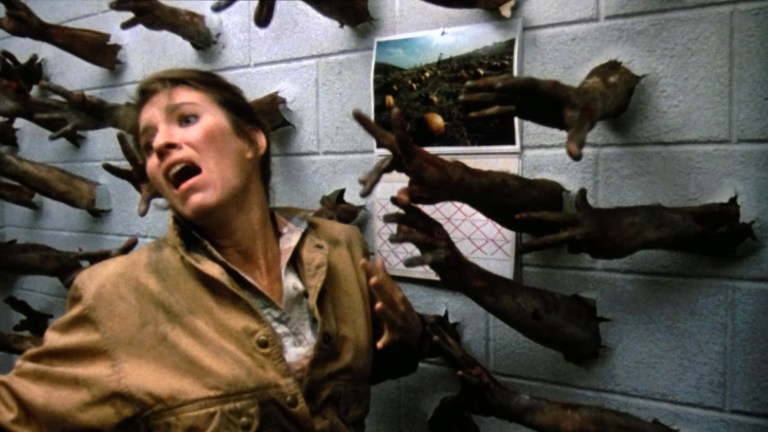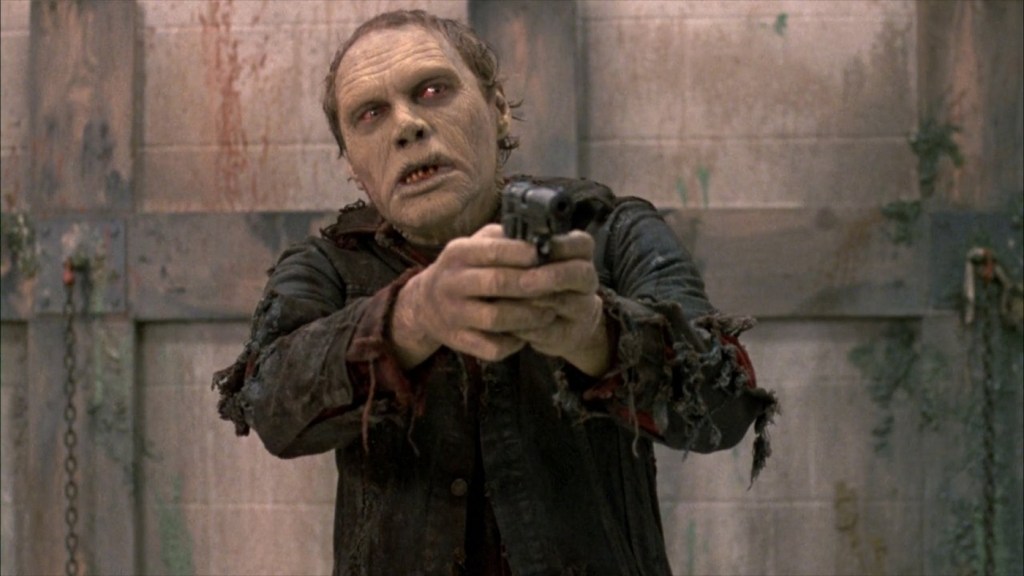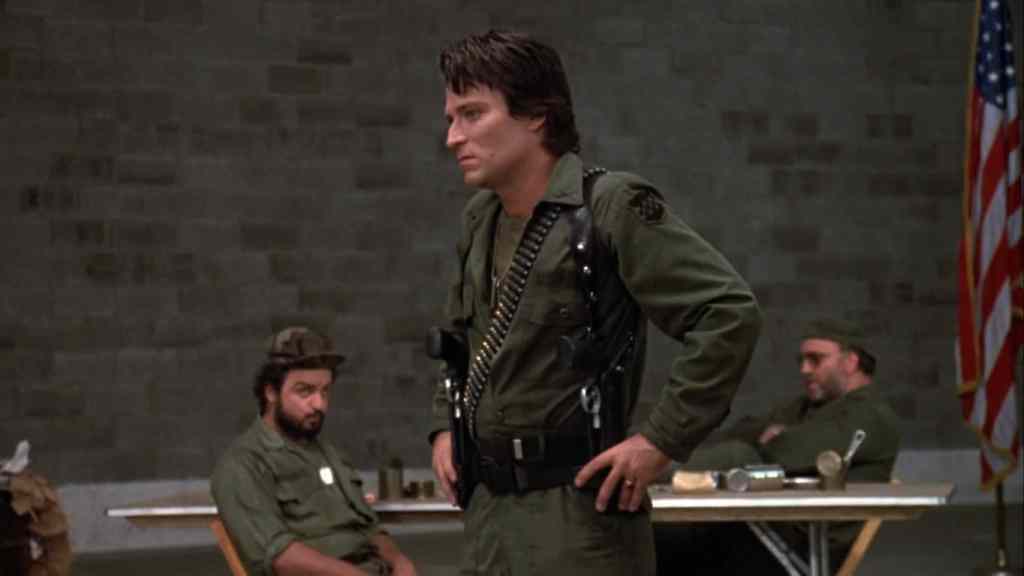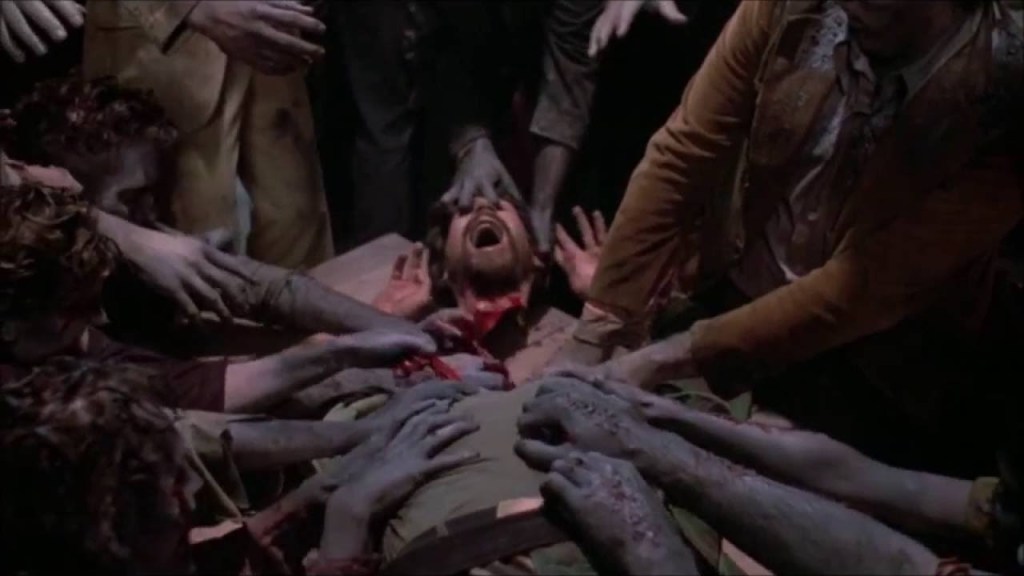Day of the Dead: George A. Romero’s Misunderstood Epic
Star Lori Cardille remembers the troubled conclusion to the horror master’s original zombie trilogy, Day of the Dead.

When legendary horror auteur George A. Romero set out to make Day of the Dead — the third chapter in a trilogy that included the wildly popular and groundbreaking Night of the Living Dead (1968) and Dawn of the Dead (1979) — he envisioned it as an epic conclusion to the story that he first began telling back in Pittsburgh in the late 1960s with a crew of friends and co-workers and a budget of just $114,000.
But the movie that Romero ended up making was not the one he started out with — and even though many were perhaps initially disappointed with Day of the Dead, it’s been re-evaluated over the years by fans, critics, and even by the late Romero himself, who wound up calling it his favorite of the original trilogy.
“When it first came out, the audience was like, ‘What the hell is this?’” says Lori Cardille, the Pittsburgh-based actress who starred as the film’s lead, scientist Sarah Bowman. “They said, ‘It’s too talky. It’s too over-the-top. These actors are too over-the-top. This is not Dawn of the Dead. I don’t know what this is, but it’s not what we expected.’ That’s why it sort of came and went, except for some people that held it and saw it for what it really was meant to be.”
Romero turned his attention to Day of the Dead after the success of 1982’s Creepshow, his collaborative homage with Stephen King to the EC horror comics of their youth. His original script for Day of the Dead was massive — with various drafts running anywhere from 122 to 204 pages — and takes place several years after the conclusion of Dawn, with the human race almost completely displaced by the reanimated dead.
A group of human refugees find their way to a tropical island — after battling both roving bands of humans and zombies — where they discover that a new civilization is rising. The lower classes live above ground in decrepit housing, while cadres of scientists and military personnel live in an underground bunker. The scientists are training the zombies to perform simple human functions — using human flesh taken from the aboveground residents as rewards — and handing them over to the military, who are shaping the ghouls into an army of the living dead.
Ruling over it all from the deepest part of the bunker is a self-styled dictator who lives in lavish style with his cronies and sycophants. But the entire situation, from the sharp division of classes to the brutal system of punishment, is primed to blow, which it does in an incredibly gruesome and explosive final battle in which the “government” is toppled — even as the zombie plague itself comes to an end.
Almost immediately, Romero’s plans for the third movie ran into problems. With an estimated budget of $7 million, it was too expensive for distributor United Film Distribution (UFD) to back — especially if it went out, like Dawn, unrated, which limited the number of theaters that would carry it. With UFD only offering to put up half the original budget — $3.5 million — Romero was forced to sit down and rewrite the script from page one, scaling back the action, the scope and the cast of characters.
Meanwhile, Romero had seen Lori Cardille in a play called Reckless and had her in mind for a major role in the original version of Day. Cardille’s father, Billy “Chilly Billy” Cardille, was a local horror host on Pittsburgh TV and an old friend of Romero who made a brief appearance in Night of the Living Dead. According to Paul Gagne’s 1987 retrospective on Romero’s films, The Zombies That Ate Pittsburgh, Romero at first wanted Lori Cardille for the role of Mary, the lead scientist, before offering her the part of Sarah, then a rebel leader. The two characters were ultimately combined when Romero revamped his screenplay.
Cardille maintains to this day that she was much happier with the version of Day of the Dead that was filmed, since it was less reliant on action and spectacle. “I’m an actress that wants to play cool characters,” she says. “So when George had to pare it down, he was more focused on character, which of course was good for the actors.”
In the filmed version of Day of the Dead, the focus is shifted to the underground military installation, where a small team of research scientists led by Sarah work fruitlessly to find a cure for the zombie plague as the living dead roam in the millions above. They are allegedly protected and supported by a squadron of soldiers, but the latter have degenerated into more or less a band of hooligans led by the megalomaniacal Captain Rhodes (Joseph Pilato). With tensions rising between the two factions, it’s only a matter of time before Rhodes and his men turn really ugly.
At the same time, the eccentric, quite likely insane Dr. Logan (Richard Liberty) is having some success reactivating the dim human memories of a zombie nicknamed Bub (Sherman Howard). The seemingly intelligent zombie recognizes music and knows how to handle certain objects — including, ominously, a gun. But when Rhodes discovers that Logan is feeding Bub pieces of dead soldiers as his reward, all hell breaks loose. The third act features some of the most incredible gore seen on screen up to that time, courtesy of the legendary Tom Savini, who took his makeup effects work to a new level with this film.

Day of the Dead began filming in October 1984, with exteriors shot at two Florida locations, Fort Myers and Sanibel Island, and interiors filmed at a limestone mine complex near Wampum, Pennsylvania. “It was grueling, and it was like a three-month shoot,” recalls Cardille. “We took a little break in there for the holidays. But we were in this cave, and we would get up early in the morning when it was dark, go to the cave, where it was dark inside, and then leave again at night, so we did not see the sunlight.”
Cardille says she can still remember the smell of the mines vividly. “We were hunkered down together in this atmosphere, and it did add to it,” she says. “It did permeate us. It’s like the dankness permeated us physically. It permeated our minds and brains, and it helped with the development of the characters and the conflicts, no doubt. The smell was kind of mildewy in a way, and there was always the sound of dripping water. There were 26 miles of lakes throughout this cave structure, so there was this dampness to it… It was actually pretty depressing, but we made the best of it, and we had a lot of fun too.”

The actress says that the entire cast became “brothers and sisters” while shooting the movie, adding that she became especially close with Joseph Pilato, who died in 2019 at the age of 70. “I got to know Joe well, of course,” Cardille reminisces. “He was a really good theater actor, and he was very, very bright. You could talk about many subjects with Joe Pilato, and he was fun to talk to.”
Cardille adds that she would see Pilato frequently on the horror convention circuit in the years after Day came out, although she laments that the actor’s personal problems eventually got the better of him. “Joe had a drinking problem,” Cardille says. “He was an alcoholic, and that was really tough for him, for his family, for his friends. And I don’t say that as a bad thing. It’s just, he had that illness and that was very painful… I think just in the long run, it sort of wrecked his body.”
On a brighter note, Cardille says she has also kept in touch with actors Terry Alexander and Jarlath Conroy, who played, respectively, the helicopter pilot and radio operator who make it out of the mines alive alongside Cardille’s Sarah. Yet even though the trio survive at the end of the movie and find their way to an uninhabited tropical island, Cardille says there was never really any talk about revisiting the characters to see where they ended up going.
“Sometimes I’d bring it up to George,” admits Cardille. “I said, ‘What about continuing these characters?’ I mean, we’re still alive.” But Cardille adds that the rights to the film and the character are tied up in various ways, making the possibility of seeing them again remote. And of course, Romero himself passed away in 2017. “It would be arrogant of us to do it,” says Cardille. “Selfishly, it would be fun to do it, and I would love to do it, but I would have loved to have done it with George.”
Although we may never find out the ultimate fate of Day of the Dead’s survivors, the movie itself lives on in more ways than one. For example, a lot of the original conception eventually found its way into Romero’s 2005 effort, Land of the Dead, in which Dennis Hopper played the slimy politician who lorded over a crumbling, walled-in section of Pittsburgh from the top of a luxury apartment tower — sort of like the underground kingdom in the original Day, only inverted.

“Once again, (George) was ahead of his time,” says Cardille. “I think of that movie a lot. I think about the wealthy people in the big tower, with the zombies outside and the grunts working to try to save humanity. It’s happening now. It feels like that in America. It is the land of the dead. All the themes are there.”
But Day of the Dead — the movie that Romero made under duress in 1985 — has grown in stature in the 35 years since its release. Although critics at the time did not treat it as kindly as Dawn, and box office was down as well (it grossed around $34 million worldwide, as opposed to Dawn’s $55 million), Day of the Dead has since escaped the shadow of its popular, satirical predecessor and managed to carve out its own space on the top shelf of horror cinema with its bleak, claustrophobic view of humanity turning against itself in the face of almost certain extinction.
“It’s a movie that has to grow on you,” Romero told author Lee Karr for his book The Making of George A. Romero’s Day of the Dead. “I think everybody wanted Dawn…but what I’ve tried to do with all the films is make them different. I mean, that makes it more fun for me.” He added, “I think it’s very much me and…it remains my favorite of all of them.”
“Day of the Dead has become a part of me,” says Lori Cardille, who largely stepped away from acting to raise a family in the years after the movie came out. “When we made it, we knew it was special and we are all still friends 35 years later. That has been a huge gift. Another gift has been meeting so many wonderful people who have been fans of the movie. I’ve learned so much from them. They taught me to appreciate the horror genre.”
Cardille also appreciates that Romero was ahead of his time in his conception of her character Sarah. “It’s also been an honor for me, as one of the first strong female characters in the horror genre, to have served as a role model for other women,” she says. “I’ve been told that the strength displayed by the character, the determination, the persistence, have served as a positive example for many young women in their lives. It is very fulfilling to know that something I helped to create will be a part of film history. I am forever grateful to George and the fans. It was an honor to bring Sarah Bowman to life.”
Watch here for more from Lori Cardille about The Living Dead, the upcoming novel from George A. Romero and Daniel Kraus — completed by Kraus after Romero’s death — that is out August 4. Cardille and actor Bruce Davison (X-Men) have read the audiobook version.
